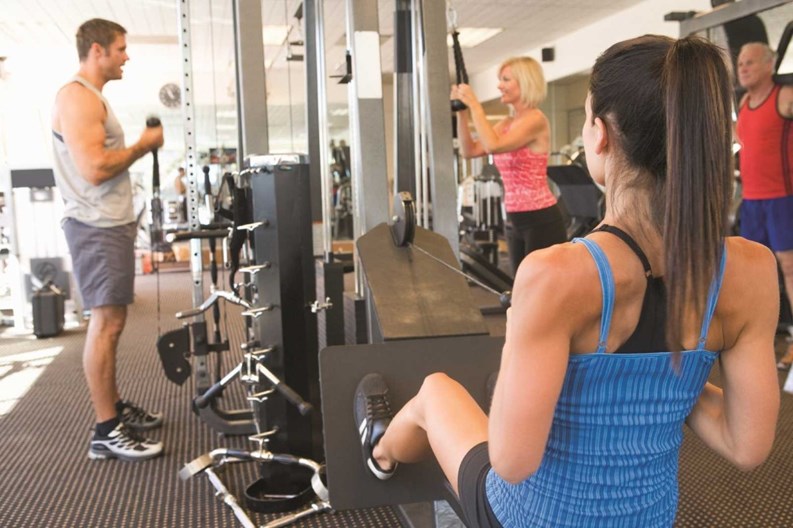Way back when, having a “gym” in your building usually meant a windowless room with a forlorn-looking treadmill, some mismatched free weights, and maybe even an old Soloflex bequeathed by a former neighbor who didn’t want to take it with him when he moved from the building down to sunny Florida.
These days, in-house gyms have come a long way—most include state-of-the-art equipment situated in bright, well-ventilated spaces, and some even employ part-time staff members, either as front-desk attendants or full-fledged trainers. But the best-run in-house gyms are no mere accident of fortune—they’re a product of excellent design, based on an understanding of liability, safety and maintenance. Cost, including setup, maintenance and other gym services, is a consideration in and of itself.
With some preparation, installing and maintaining a new gym—or even upgrading an existing facility—in a co-op or condo building can be a project that even board members and other residents with zero construction experience will feel comfortable undertaking. Part of what’s required is self-education; the rest concerns having the right professionals to guide you through the process.
Pumping Up
If a building decides to establish a gym, management must ascertain what equipment and activities will be provided for, and how much the space will likely be used. For many buildings, the process begins with the creation of a committee tasked with handling the planning and installation of the facility. The board of directors appoints a group of residents (possibly including some board members) to determine what type of facility would best meet the needs and expectations of the building community.
Since planning a functional, efficient fitness facility isn't simply a matter of buying some weights and calling it a day, one of a gym committee's first duties should be hiring a fitness consultant to give expert insight and help them through the process. The committee, through its own research, input from other residents, and with the help of the consultant, will determine what will make the best use of the planned facility. The consultant will help the committee choose what equipment to purchase, where it should be placed to maximize user experience, and what items they can simply leave out, says Bob Hoshour, vice president of sales & marketing for Ithaca-based Advantage Sports & Fitness, Inc.
But how do consultants help to figure out use of a planned facility that’s new to the building? First off, management must consider where exactly in the building they want to locate the gym. That means answering the question of where in the building is there a room (or rooms) that comprise at least 400 square feet of space. Depending upon the available space and what’s deemed necessary equipment, the layout of the space could vary widely.
There's also the issue of traffic to consider. Thomas Jackowski, a consultant for Gym Source, which has locations in New York City and nationwide, has developed a formula through which he determines the expected use of a given fitness room. He first scouts the location of the building, to evaluate how many membership-based gyms are in the vicinity. The Upper East Side of Manhattan for example has lots of gyms, and so a new in-house gym in that area might get less use than others in areas of the city not as well served by commercial fitness centers, he says. “People tend to work, shop and do other daily things within a five block radius.”
Based in part upon the density of commercial gyms in the area, the number and type of co-op apartments or condo units in the building for which a gym is planned, as well as the number of residents age 17 and older living in the building, Jackowski can estimate the number of regular users (i.e., folks who are likely to use the planned gym facility at least twice a week). From all of that accumulated research, he will recommend equipment for the facility, as well as a proposed layout.
Along with square footage and predicted use, it's also advisable to have your building's engineer conduct a feasibility study to determine the workability of the proposed space. Considerations such as low-hanging pipes or potentially very tight quarters in the gym might not be apparent to board members but an engineer who visits the site and measures it and evaluates its usability will spot those and other potential problems—and perhaps work out some alternatives with the project's fitness consultant and the board's committee. All this before the board forges ahead and creates a gym that’s doomed to not work. The consultant’s planned layout of the gym might not jibe with the engineer’s expectation of the need for infrastructure changes to the space, such as the installation of heating/cooling ductwork, or a dropped ceiling. Even if there are no structural issues to be worked around, an engineer's input can be very useful as the committee and its consultants strive to make the most sensible use of the available space.
Building In
In an existing building, the largest challenge in the design process—might simply be finding the proper space to build a gym. “The biggest obstacle I’ve seen is finding a room that can be converted to a gym. What’s happening a lot is the laundry rooms aren’t being used as much, and so the laundry room can be shrunk or removed,” Hoshour says.
But again, such a space, while convertible, may have inherent obstacles of its own, such as the need to remove unnecessary plumbing and excessive electrical outlets. A preliminary blueprint for the gym will include ductwork, electrical lines and other infrastructure improvements required for the gym, as well as description of where each piece of equipment will be located.
One design issue for some buildings planning to create an in-house gym is that the space they’ve chosen for the gym is hard to work with. Ceiling heights in the room may be too low, or because of the floor that it’s located on, the gym room could be subject to weight limitations or occupancy limitations, says Brian Mahoney, of Fitness Management Solutions, in Bayonne, New Jersey. “We get really awkward spaces, and so you have to personalize the design,” he says. “You have to make the gym adaptable, and safe.” Other considerations, like location, are important to the usability of an in-house gym. If the gym is in a distant, hard to reach part of the building, far from the elevator and in a poorly lit, uninviting spot, it’s liable to accumulate dust, rather than gather fitness enthusiasts.
But one of the biggest no-no’s in a gym installation is letting the client drive the project, Jackowski says. “Stand on proper design principles. A poorly designed gym will not be used, and it will be a waste of money,” he says.
Assessing Needs
Any fitness expert hired by the board must know their business. Having them be an expert in their field is about as crucial as having an engineer know their profession. The gym expert should not only be an expert in fitness, but also in fitness equipment, since certain kinds of equipment will be best suited for residents in particular buildings. A building with a lot of elderly residents might not need as wide a range of free weights as a building that's home to a lot of young professionals, for example. Depending on the community, just having an assembly of well-maintained equipment might be all that's needed of a gym, while other buildings might want to have instructors on hand to teach yoga or Zumba classes. The latter type of community might want to engage professionals to come on-site regularly to lead classes—or even come in and do personal fitness evaluations. According to the professionals, some high-end buildings bring in registered dieticians to consult with residents, or have massage therapists come in on regular schedules. It’s really a matter of how much service the residents feel they need from their gym consultant—and what they're willing to pay for.
Unlike a health club, which is a for-profit facility with a full hierarchy of employees and management, an in-house residential gym is usually not staffed, or minimally so, and often is far smaller. That lack of staff—as well as liability and insurance considerations—is partly the reason why only certain types of equipment are usually included in a residential fitness room.
Weighty Issues
Because of those liability issues, knowing specifically what gym equipment the building needs is crucial. Easy-to-use equipment such as treadmills and cross-trainers that are the most frequently used in any gym, are expected. Generally, a building’s umbrella insurance policy will cover some—but not all—gym equipment. Once you install heavier free weights or enable users to do exercises that might require a spotter, your liability increases. “Having any free weights over 50 pounds requires a rider to the policy, or the insurance companies don’t want to cover their use,” Jackowski says.
In addition to insurance, any in-house gym will have its own unique operating costs, which will vary depending upon the size of the room, how often it is used, what equipment it contains and what professional services go with it. First, utility costs including heating/cooling, lighting and electrical power for equipment is a constant but may not be too pricey for a small, 400 square-foot gym. But if you increase the gym’s size and equipment, those costs can drastically increase. Then add the costs associated with having individual TVs on cardio equipment, and you can see how just the “bare minimum” expenditures can add up.
Of course, maintenance is one absolutely crucial service needed to keep a gym safe and reliable. Without proper and regular maintenance, the equipment won’t last. Even with regular maintenance, cardio machines last only about 5 to 10 years, and strength training machines last about a decade or so, Jackowski says. Regular maintenance for these machines means, first of all, routine cleaning, as often as needed. Typically, exercise equipment is serviced (with interiors cleaned) about four times per year. Sometimes they are serviced as little as twice a year, or as often as every other month, depending on the level of traffic through the facility.
Servicing the equipment also means having the maintenance expert lubricate those machines which require it, and replace belts and other parts that tend to wear out. Cleaning the actual gym space, and the exterior of the machines, can be done as frequently as twice daily: once in the morning after the early rush, and once in early evening after the late day busy stretch. In addition to wiping down the machines, employees should vacuum carpeting, mop rubber floors and clean mirrors.
Often, the fact that an existing gym space just isn't working for residents prompts management to ask an expert for help. “Property managers have contacted us because they were getting lots of complaints,” Mahoney says. “Other times, a property manager may be getting requests for services, like someone to come in and teach a prenatal Yoga class on Saturday mornings. The days of an in-house fitness space being a spot that only the local gym rats frequented is as far gone as the 1990s. Now, residents and potential buyers in a building expect much more.
Working with experienced fitness consultants—as well as engineering professionals, and listening to your own residents' needs—can ensure that your fitness facility is a well-used, much-loved fixture in your own particular building.
Jonathan Barnes is a freelance writer who regularly contributes to The Cooperator.







Leave a Comment